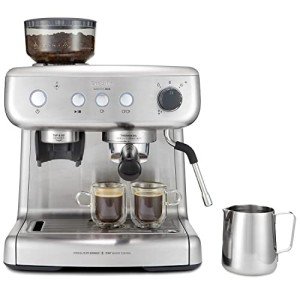Home Use Espresso Machines The Process Isn't As Hard As You Think

Home Use Espresso Machines: A Comprehensive Guide
Espresso machines have actually become a staple in numerous families as coffee lovers look for to duplicate café-quality brews in the convenience of their kitchen areas. The increase in appeal has caused a varied market filled with different designs, functions, and prices. This article intends to supply an informative summary of home use espresso machines, assisting readers browse their alternatives successfully.
Comprehending Espresso Machines
Espresso machines work by forcing warm water through finely-ground coffee under high pressure, resulting in a focused coffee drink understood as espresso. There are a number of types of espresso machines classified based upon their developing methods and level of automation. The most common types consist of:
- Manual Espresso Machines: These require the user to manage the pressure and water circulation, enabling a more hands-on coffee-making experience.
- Semi-Automatic Espresso Machines: These offer automatic control over water pressure, while the user by hand grinds and tamps the coffee.
- Automatic Espresso Machines: With the push of a button, these machines instantly manage the circulation of water, making it much easier to brew espresso with consistent results.
- Super-Automatic Espresso Machines: These all-in-one machines manage grinding, tampering, brewing, and even milk frothing, making them perfect for users looking for convenience.
- Pill or Pod Machines: These use pre-packaged coffee pods to produce espresso with very little effort, however they restrict option in developing techniques and tastes.
Table: Comparison of Espresso Machine Types
| Type | Control Level | Alleviate of Use | Cleaning up Level | Perfect For |
|---|---|---|---|---|
| Manual | User-controlled | Moderate | High | Coffee purists |
| Semi-Automatic | Partial automation | Moderate | Moderate | Home baristas |
| Automatic | Totally automated | Easy | Low | Hectic people |
| Super-Automatic | Totally automated | Very simple | Really low | Convenience hunters |
| Capsule/Pod | Completely automated | Very easy | Extremely low | Casual drinkers |
Secret Features to Consider
When picking a home use espresso machine, it's necessary to think about different features that can considerably impact the quality of espresso and user experience.
- Pressure: Look for machines that offer at least 9 bars of pressure, as this is considered ideal for brewing espresso.
- Boiler Systems: Single vs. dual boiler systems figure out temperature level stability and the ability to brew espresso and steam milk concurrently.
- Grinder: Integrated mills permit newly ground coffee, which improves taste. Think about machines with adjustable grind settings.
- Milk Frother: For those who take pleasure in coffees and lattes, a built-in steam wand or automatic frother is essential.
- Size and Design: Consider your kitchen area space and visual choices. Online Espresso Machines Store can be found in numerous sizes, from compact to big setups.
- Cost: Home espresso machines can range from a few hundred to several thousand dollars, so it's vital to develop a budget before checking out choices.
Benefits and drawbacks of Home Use Espresso Machines
| Pros | Cons |
|---|---|
| Convenience of brewing coffee in the house | Preliminary investment can be high |
| Quality of espresso is often superior | Requires some skill, specifically with manual machines |
| Capability to explore tastes | Upkeep and cleansing can be labor-intensive |
| Can conserve cash in the long run | Not all machines will match every coffee preference |
Upkeep and Cleaning Tips
Maintaining an espresso machine is essential for extending its life and ensuring consistent brew quality. Here are some useful suggestions:
- Regular Descaling: Minerals from water can build up in the machine. Descale every 1-3 months, depending upon water hardness.
- Daily Cleaning: Rinse portafilters, baskets, and steam wands after each use to prevent coffee oils from building residue.
- Use Filtered Water: This can help in reducing mineral accumulation and improve the taste of coffee.
- Change Gaskets and Seals: These components might wear gradually and needs to be changed to preserve pressure and performance.
- Read the Manual: Each machine has particular care directions; following these will make sure longevity.
Frequently Asked Questions About Home Use Espresso Machines
Q1: What is the best budget espresso machine?The best budget espresso machine typically depends upon specific needs, but models like the DeLonghi EC155 or the Breville Bambino are popular among users for providing excellent value. Q2: How long do home espresso machines normally last?With appropriate upkeep, home espresso machines can last anywhere from 5 to 15 years, depending on the quality of the machine and frequency of use. Q3: Can I make coffees and lattes with any espresso machine?While most espresso machines can make coffees and lattes, having a trustworthy
steam wand or frother is important for achieving the best milk texture.
Q4: Are super-automatic machines worth the investment?For those who focus on benefit and fast brewing, super-automatic machines can be worth the financial investment, though they may lack some customizability in brew strength and taste. Q5: What kinds of coffee beans are best for espresso?While personal choice plays a function, beans labeled as" espresso "blends are generally roasted darker, developing rich tastes and a velvety texture when brewed.
Investing in a home espresso machine can change the everyday coffee regimen into something special, raising home brews to café quality. By comprehending the various kinds of machines, key features to think about, maintenance needs, and weighing the
benefits and drawbacks, consumers can make educated choices that fit their specific preferences. As the espresso culture continues to grow, no matter the option, every brew can be a scrumptious experience waiting to be savored.

